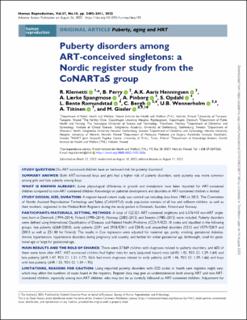| dc.description.abstract | STUDY QUESTION
Do ART-conceived children have an increased risk for puberty disorders?
SUMMARY ANSWER
Both ART-conceived boys and girls had a higher risk of puberty disorders; early puberty was more common among girls and late puberty among boys.
WHAT IS KNOWN ALREADY
Some physiological differences in growth and metabolism have been reported for ART-conceived children compared to non-ART-conceived children. Knowledge on pubertal development and disorders in ART-conceived children is limited.
STUDY DESIGN, SIZE, DURATION
A register-based cohort study was carried out including data from 1985 to 2015. The Committee of Nordic Assisted Reproductive Technology and Safety (CoNARTaS) study population consists of all live and stillborn children, as well as their mothers, registered in the Medical Birth Registers during the study period in Denmark, Sweden, Finland and Norway.
PARTICIPANTS/MATERIALS, SETTING, METHODS
A total of 122 321 ART-conceived singletons and 6 576 410 non-ART singletons born in Denmark (1994–2014), Finland (1990–2014), Norway (2002–2015) and Sweden (1985–2015) were included. Puberty disorders were defined using International Classification of Diseases and Related Health Problems (ICD)-9/ICD-10 codes and classified in the following groups: late puberty (6268/E30.0), early puberty (2591 and 2958/E30.1 and E30.8) and unspecified disorders (V212 and V579/E30.9 and Z00.3 as well as Z51.80 for Finland). The results in Cox regression were adjusted for maternal age, parity, smoking, gestational diabetes, chronic hypertension, hypertensive disorders during pregnancy and country, and further for either gestational age, birthweight, small for gestational age or large for gestational age.
MAIN RESULTS AND THE ROLE OF CHANCE
There were 37 869 children with diagnoses related to puberty disorders, and 603 of them were born after ART. ART-conceived children had higher risks for early (adjusted hazard ratio (aHR) 1.45, 95% CI: 1.29–1.64) and late puberty (aHR 1.47, 95% CI: 1.21–1.77). Girls had more diagnoses related to early puberty (aHR 1.46, 95% CI: 1.29–1.66) and boys with late puberty (aHR 1.55, 95% CI: 1.24–1.95).
LIMITATIONS, REASONS FOR CAUTION
Using reported puberty disorders with ICD codes in health care registers might vary, which may affect the numbers of cases found in the registers. Register data may give an underestimation both among ART and non-ART-conceived children, especially among non-ART children, who may not be as carefully followed as ART-conceived children. Adjustment for causes and duration of infertility, mothers’ own puberty characteristics and BMI, as well as children’s BMI, was not possible because data were not available or data were missing for the early years. It was also not possible to compare ART to non-ART siblings or to study the pubertal disorders by cause of subfertility owing to a small number of discordant sibling pairs and a large proportion of missing data on cause of subfertility.
WIDER IMPLICATIONS OF THE FINDINGS
This large, register-based study suggests that ART-conceived children have a higher risk for puberty disorders. However, the mechanisms of infertility and pubertal onset are complex, and ART is a rapidly advancing field with various treatment options. Studying the pubertal disorders of ART-conceived offspring is a continuing challenge.
STUDY FUNDING/COMPETING INTEREST(S)
This work was supported by the Nordic Trial Alliance: a pilot project jointly funded by the Nordic Council of Ministers and NordForsk (71450), the Central Norway Regional Health Authorities (46045000), the Nordic Federation of Obstetrics and Gynaecology (NF13041, NF15058, NF16026 and NF17043), the Interreg Öresund-Kattegat-Skagerrak European Regional Development Fund (ReproUnion project), the Research Council of Norway’s Centre of Excellence funding scheme (262700), the Swedish state under the agreement between the Swedish government and the county councils, the ALF-agreement (ALFGBG-70940) and FLUX Consortium ‘Family Formation in Flux—Causes, Consequences and Possible Futures’, funded by the Strategic Research Council, Academy of Finland (DEMOGRAPHY 345130). The funders had no role in study design, data collection and analysis, decision to publish or preparation of the manuscript. The authors have no conflicts of interest to disclose.
TRIAL REGISTRATION NUMBER
N/A. | en_US |

